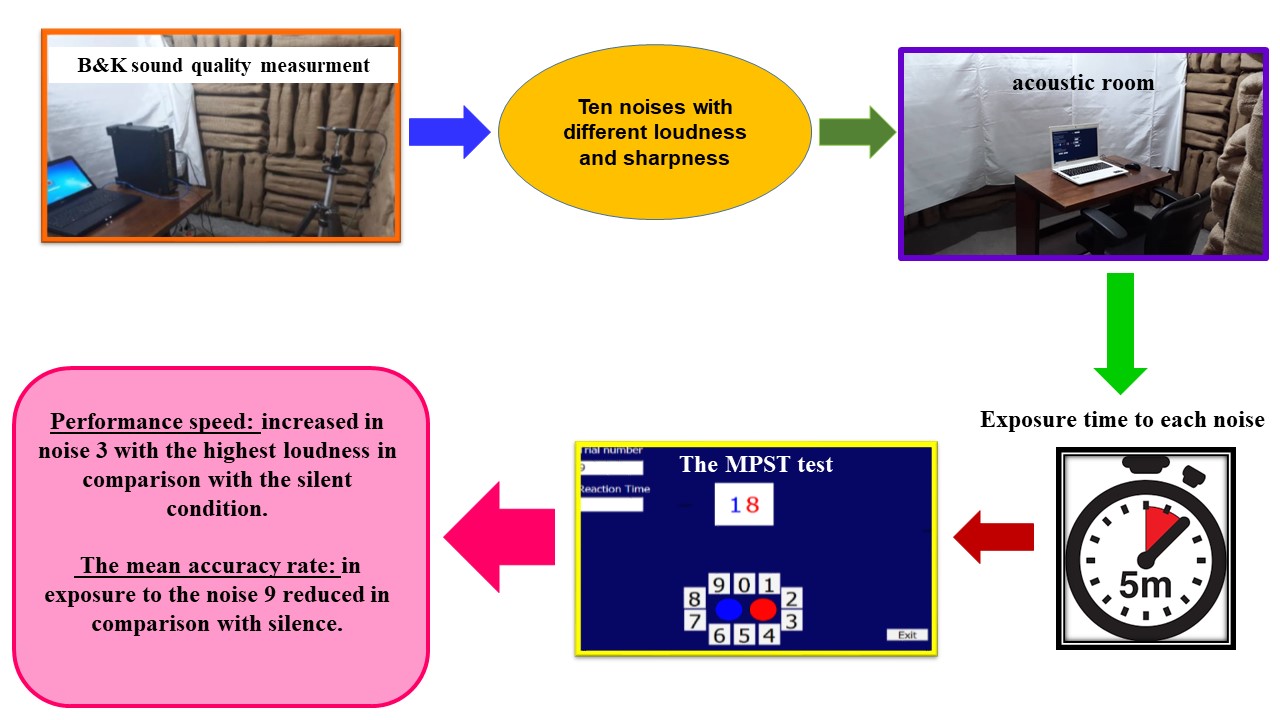Volume 12, Issue 1 (3-2022)
J Health Saf Work 2022, 12(1): 67-81 |
Back to browse issues page
Download citation:
BibTeX | RIS | EndNote | Medlars | ProCite | Reference Manager | RefWorks
Send citation to:



BibTeX | RIS | EndNote | Medlars | ProCite | Reference Manager | RefWorks
Send citation to:
Mehrabi Matin A, Alefi M, Monazzam M R, Mazloumi A, Azam K. Study of Noise Loudness and Sharpness Effects on Cognitive Performance on Male Students of Tehran University of Medical Sciences. J Health Saf Work 2022; 12 (1) :67-81
URL: http://jhsw.tums.ac.ir/article-1-6634-en.html
URL: http://jhsw.tums.ac.ir/article-1-6634-en.html
1- Department of occupational health, School of public health , Tehran University of Medical Sciences, Tehran, Iran , mehrabi.azar@gmail.com
2- Department of occupational health, School of public health , Tehran University of Medical Sciences, Tehran, Iran
3- Department of Epidemiology and Biostatistics, School of Public Health, Tehran University of Medical Sciences, Tehran, Iran
2- Department of occupational health, School of public health , Tehran University of Medical Sciences, Tehran, Iran
3- Department of Epidemiology and Biostatistics, School of Public Health, Tehran University of Medical Sciences, Tehran, Iran
Abstract: (2371 Views)
Introduction: The noise could affect some aspects of human health, including the cognitive performance. In addition to sound pressure level and exposure time, the psychoacoustic features of noise may cause destructive effects on humans. A few recent studies have been conducted on effect of sound quality on cognitive performance. This study aims to find the noise loudness and sharpness levels as the most destructive effects on human cognitive performance.
Material and Methods: This was a cross-sectional study on 10 male students of Tehran University of Medical Sciences. The Noises were generated in two channels that the left channel produced the pink noise as a background noise. The pink noise loudness and sharpness were 19.7 sone and 2.49 acum, respectively. The right channel generated noises with different loudness and sharpness levels the noise loudness ranged from 8.87 to 67.9 sone and the noise sharpness ranged from 1.07 to 6.4 acum. Finally, ten noises with different loudness and sharpness were applied. The students were exposed to ten different types of noise and a silent condition. The Mathematical Problem Solving Task (MPST) test was performed to assess cognitive performance. The reaction time and the accuracy rate were measured after 5 minutes of noise exposure. Data were analyzed by SPSS (ver. 22). P< 0.05 was considered as significant level.
Results: The mean reaction time and the mean accuracy rate increased with the sharpness level. However, alteration in the loudness and sharpness levels had no significant effect on the speed and accuracy of students. Performance speed increased in noise 3 with the highest loudness (L=67.9, SH=1.07) in comparison with the silent condition (p-value=0.05). The mean accuracy rate in exposure to the noise 9 reduced in comparison with silence (p-value=0.04)
Conclusion: Different levels of psychoacoustic features had no significant effect on the cognitive performance parameters. Although, the accuracy rate and the reaction time decreased in noises 9, the sharpest noise, and 3, the loudest noise, in comparison to the silence, respectively.
Material and Methods: This was a cross-sectional study on 10 male students of Tehran University of Medical Sciences. The Noises were generated in two channels that the left channel produced the pink noise as a background noise. The pink noise loudness and sharpness were 19.7 sone and 2.49 acum, respectively. The right channel generated noises with different loudness and sharpness levels the noise loudness ranged from 8.87 to 67.9 sone and the noise sharpness ranged from 1.07 to 6.4 acum. Finally, ten noises with different loudness and sharpness were applied. The students were exposed to ten different types of noise and a silent condition. The Mathematical Problem Solving Task (MPST) test was performed to assess cognitive performance. The reaction time and the accuracy rate were measured after 5 minutes of noise exposure. Data were analyzed by SPSS (ver. 22). P< 0.05 was considered as significant level.
Results: The mean reaction time and the mean accuracy rate increased with the sharpness level. However, alteration in the loudness and sharpness levels had no significant effect on the speed and accuracy of students. Performance speed increased in noise 3 with the highest loudness (L=67.9, SH=1.07) in comparison with the silent condition (p-value=0.05). The mean accuracy rate in exposure to the noise 9 reduced in comparison with silence (p-value=0.04)
Conclusion: Different levels of psychoacoustic features had no significant effect on the cognitive performance parameters. Although, the accuracy rate and the reaction time decreased in noises 9, the sharpest noise, and 3, the loudest noise, in comparison to the silence, respectively.
Keywords: Noise, psychoacoustic, loudness, sharpness, cognitive performance, reaction time, accuracy rate
Type of Study: Research |
Received: 2022/03/6 | Accepted: 2022/03/30 | Published: 2022/03/30
Received: 2022/03/6 | Accepted: 2022/03/30 | Published: 2022/03/30
Send email to the article author
| Rights and permissions | |
 |
This work is licensed under a Creative Commons Attribution-NonCommercial 4.0 International License. |







